 |
| Denali National Park |
We spent the first night in Fairbanks at our go-to place, The River’s Edge Resort. Nice room where we collapsed from exhaustion. But, that was a mistake. While we slept, there was apparently some pretty good aurora.
The next three days were in Denali.
 |
| Denali National Park |
I will split my coverage into three sections. Not chronological, but by location: inside the restricted area of the Park, normally Mile 15 to Mile 92 (“Inside”), the part of the Park where you can drive your own car, including the main Visitor Center and the first 15 miles of the road (“Self-Drive”); and outside the Park, including the town of Healy ("Outside").
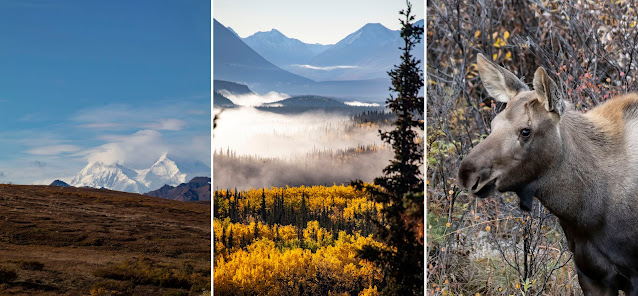 |
| Inside, Outside, Self-Drive |
 |
| Where you can and can't go by car |
Because the environment is fragile, you can’t drive your own vehicle past 15 miles of the 92-mile Park Road, with some exceptions.
There is great stuff in the first 15 miles, especially lots of Moose and Porcupines. During the fall, this area is a great place to visit because its where the Moose gather for the rut. If you are lucky, you can see some big boys with pretty good-sized antlers.
The Park’s shuttle bus system begins limited service in May and full service in early June, weather permitting. Buses run until mid-September. We usually visit in mid-September and, one year, we were on the last bus of the day on the last day of the season.
 |
| Fall is a nice time to visit |
 |
| A tour bus (there was allegedly a Lynx right by the road here; we never saw it) |
They have a variety of route lengths. I have always liked to go all the way to the end and back at least once. Several times, we have stayed at the Backcountry Lodge, which included 92-mile-long (all day) bus rides to and from.
 |
| It takes all eyes to find the good stuff |
ALL buses – even the transit shuttles – have experienced drivers who provide narration and stop for wildlife.
Since the driver is spotting AND driving, the passengers carry a great deal of responsibility for finding wildlife. Photographers are always the best spotters.
There is a Road Lottery you can enter in May that, should you win, permits you to drive your own vehicle the entire road during the second weekend after Labor Day. It is a great opportunity, but sometimes weather keeps the winners from collecting the prize.
Once the lottery weekend is over, all private vehicles may drive up to 30 miles into the park until snow closes the road for the season. We have done this – and it delivered a Canadian Lynx!
So, the day we arrived at Denali (the day before our booked tours), we checked in at the reservation desk to make sure everything was OK. It wasn’t.
First, there were still no transit reservations, so we were to stick with our scheduled Tundra Wildlife Tours (no biggie).
 |
| Our ride for two days |
Second, that 6:40 a.m. “start time” was misleading. In the past, I had been able to pick a start time and I always picked early morning because that’s good time to see animals.
 |
| It did say start time was subject to change |
Now, all tours are listed as 6:40 a.m. and, then the day before, they email you with your real start time, which can be much later. This was not clearly explained at the time of booking. Ours were 9:00-ish one day and 10:00-ish the second. Because we were traveling, I had not seen the email.
I was surprised and I overheard several other people who were equally surprised, including a couple that had driven down very early only to have to wait several hours for their tour.
Third, and this is the worst. About two weeks earlier (while we were in Iceland and not seeing lots of news), the Park closed the road at Mile 43 (that is only halfway in), dramatically reducing the amount of Park any visitors could see and shortening the tours. This decision to close was based on serious road degradation that will take major engineering and funding to fix.
 |
| Photo: National Park Service |
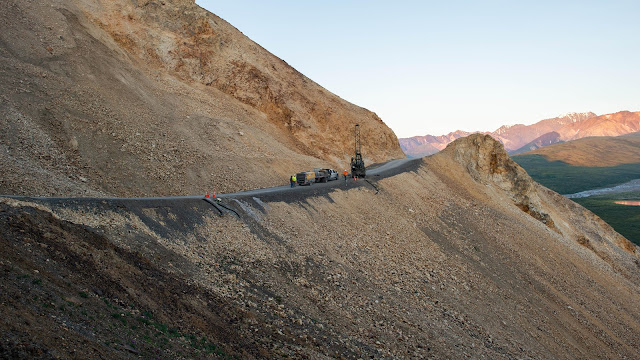 |
| Photo: National Park Service |
Early August rains in 2021 appear to have triggered the rate to increase significantly, with much of the landslide currently moving downhill at over ten inches per day. The day before the closure, it was 17 inches in one day.
 |
| Landslides and repairs have moved the road up and down; Chart: NPS |
A ranger explained to us that the cliff on which the road is built isn’t actually solid rock. Rather, it is rock bound in ice. Climate warming is weakening the entire mountain.
The road west of Mile 43 was closed to nonessential vehicles in August because of the landslides. More than 80 backpackers, campers and guests of the lodges had to be evacuated.
 |
| A bus leaving the turn-around point |
According to the Anchorage Daily News, the roadbed has since slumped about 30 feet since September. The Park is now looking at building a permanent bridge over the slide area.
 |
| Illustration: National Park Service |
 |
| Illustration: National Park Service |
So, we were looking at a shorter trip with less ground to cover. Still, we opted to stay both days because, at Denali, you never know what you’ll see. That turned out to be a good decision because the two days had different weather and different animals.
Interestingly, although our tours were at different times, we had the same tour guide. She was pleasant and well-informed, so that wasn’t a problem. But, all drivers have their own spiel and stories. By the end of the season, they are pretty set. So, we got to hear Donna twice (pretty much word-for-word).
 |
| Donna, our driver, and me on the bus; Photos: Scott Stevens |
 |
| Dall Sheep on the screen |
For folks who have difficulty seeing distant wildlife, this is a big plus. And, for those having trouble finding the actual wildlife with their own eyes (happens all the time in that vast area), it helps give an idea where to start looking.
There are several stops where you can get out (including a couple of potty breaks at the nice rest areas along the route).
 |
| The Teklanika Rest Stop (Mile 30) has some nice views |
 |
| But, we aren't newbies! |
Over the two days we visited inside the Park, we had some animal sightings. But as seasoned Denali visitors, we have had much, much better encounters on previous trips.
Yes, we are a bit (a lot!) jaded.
What we saw would have been pretty good for a newbie.
We did see Caribou. A good number, but kind of far away.
And, over two days, we saw four Grizzly Bears.
None were particularly close ...
 |
| Brown Bear (AKA Grizzly Bear) on the hill |
... but this is why you have a long lens. It’s always a good day when you see a Bear, no matter how far away ...
 |
| Coming down the hill |
Apparently, the area where the road is closed is in the middle of the most common place to see Grizzlies. I have seen them multiple places in the Park (including once about one minute out of the bus depot), but this is the area where you have the best chance.
 |
| Digging for squirrels and walking away |
We had some good encounters with Spruce Grouse …
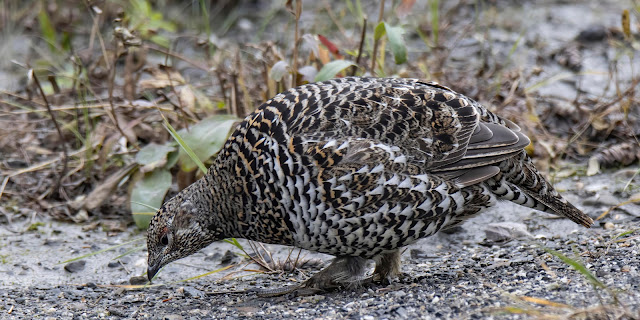 |
| Roadside Grouse |
And, we saw a couple of Arctic Ground Squirrels ...
This was one of the few trips where we saw no Foxes or Moose within the restricted driving area. What we did see (and we have also seen this before), was 20,310-foot-tall Denali, the tallest mountain in North America.
You may hear that it is obscured by clouds at least 75 percent of the time and you won’t see it if you visit the Park. But, climate change seems to be revealing the mountain more often. I have seen it every time I have visited since 2008.
This time, we got good views from both “Inside” the Park and from the "Self-Drive" Area.
 |
| Denali from another vantage point |
Because it was September, the foliage was rapidly changing to the dramatic yellows, reds and oranges of a Denali fall.
We could see more color as each day progressed.
We’ve been in Denali in previous Septembers where there was already significant snow, but this year was still fall with just a hint of coming winter.
Self-Drive Area
We had a couple of good sightings in the Self-Drive area, both from the tour bus (this area is part of the tour) and from our own car. The biggest draw is Moose.
We did see a couple of big bulls, but, unfortunately, they were either very far away ...
… or in deep grass …
 |
| Is this? |
We seemed to just miss a couple that were near the road. But, that’s the way it goes.
We had better luck with cows and calves. We had good encounters with a mom ...
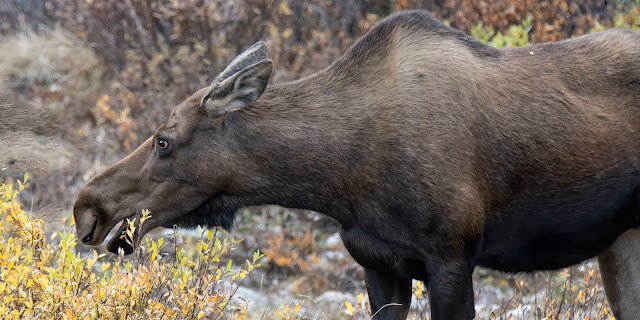 |
| A beautiful cow |
... and her yearling …
 |
| Still a baby |
The baby was quite grown as winter approaches, but still gangly and cute.
You might wonder why we care so much about Moose. After all, there are plentiful Moose to be seen in Colorado. True, but Colorado has Shiras Moose. Alaska has Alaskan Moose.
 |
Ranges of the four Moose species: Mooseword.com |
Males average 1,400 lbs., but can reach 1,800. They can stand seven feet at the shoulder and have an 80-inch antler span. That is big!
 |
| One of the big boys |
We also had two great sightings of Northern Hawk Owls, the Owl most commonly seen in Denali.
The first one was in great light and was extremely interested in us, making for great photos.
 |
| Peeking at us from his perch |
The second was in much less favorable light and it wasn’t particularly interested at first because it had a meal to eat.
 |
| He caught a vole and landed in a nearby tree |
Once the owl had consumed the vole …
 |
| Down the hatch! |
… then it wanted to know just what we were up to …
 |
| You lookin' at me? |
I just love Owls.
 |
| Doesn't everyone love Owls? |
 |
| Not a good photo, but a great sighting |
The Savage River Area is also along this route. We stopped and took a walk along the trail where I have seen a lot of birds before.
Close to the developed areas of the park is a very picturesque railroad bridge. We were fortunate on this trip, to be able to catch the Alaska Railroad as it headed into the Denali Station.
 |
| The Alaska Railroad |
We have never taken the train, but it might be fun.
We were also able to make it to a second scenic railroad bridge to catch the train after it pulled out of Denali Station. We rushed because we didn't know how long it would take to make it there.
Turns out we had plenty of time.
There’s just something about photographing a train!
While in the Denali area, we stayed at the Aurora Denali Lodge in Healy. A bit farther away than some of the cabins we have stayed in before, it was nice with a spacious room.
 |
| The Aurora Denali Lodge; Photos: Booking.com |
It can be tricky getting services – hotels and meals – near the Park as businesses start to shut down for the season. This year was even more difficult because many restaurants had shut down (I fear some permanently) because of COVID. So, getting dinner was an issue.
 |
| Serbian sangria! |
We found one (very popular) spot, where we ended up eating twice (one snack, one dinner). Cleverly named Moose-AKAs, the restaurant specialized in delicious Serbian food. It was an unexpected treat.
And, boy was it busy (I mean, even the Subway had closed for the year).
My favorite was mekice, a fried bread with a red pepper sauce and cream cheese. I could eat that every day!
 |
| Photo: Moose-AKAs |
On our last day in Denali, we even awoke to what Alaskans call “termination dust:” the first light snow of the season.
 |
| The signal that the season is ending |
Denali Always Delivers
Our visit to Denali was pleasant. I have had better animal sightings and I was certainly sad that the road was closed halfway. But, we did see a Lynx and Bears …
… Moose …
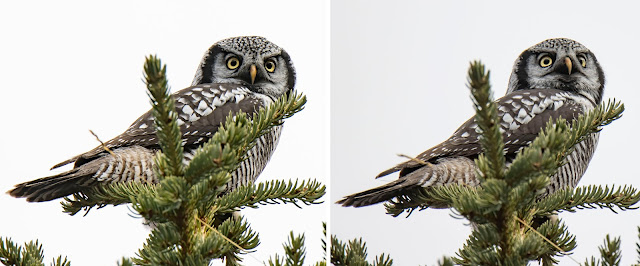 |
| Northern Hawk Owl |
… Caribou …
... very few birds ...





























No comments:
Post a Comment